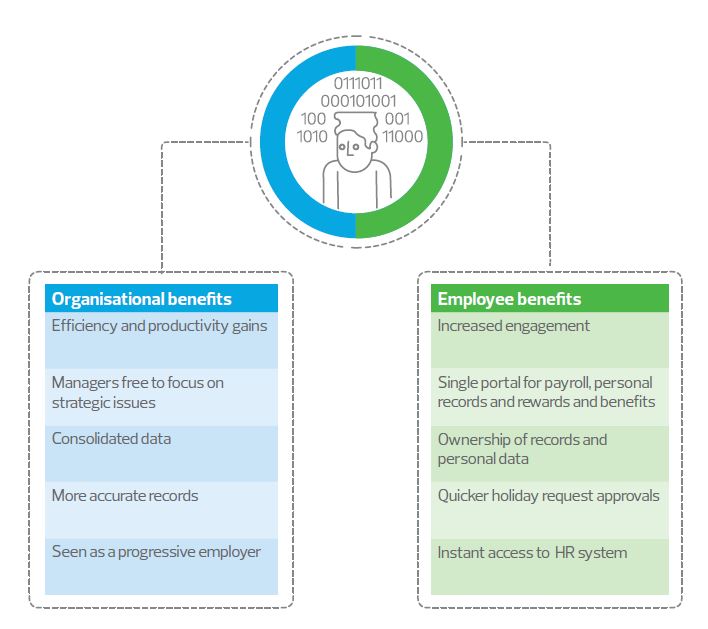
How long does it take for your organisation to onboard employees, approve holiday requests, process sick leave or alter payroll records? As technology transforms the world we live in, your people have a growing expectation that you’ll be able to do this instantly. Can your analogue systems keep up?
There is now a major disconnect between the way we use technology at home and at work. Every day, we use our devices to connect with friends, shop, book holidays and pay our bills. Yet organisations have struggled to keep up. Many employees now feel like they’re stepping back in time when they cross the company threshold.
Digital technology has transformed every aspect of our personal lives. Yet too many organisations still rely on clumsy paper-based systems and multiple spreadsheets to manage their people. Employees often have to wait days before their personal records can be updated or their holiday requests and sick leave are processed. When forms are shuffled between desks and in-trays before being uploaded by administrators, it can quickly undermine morale and motivation.
Today’s digitally savvy employees want to be able to use technology at work in the same way as they do in their personal lives. They demand the tools to book their own time off, instantly access their records and opt-in to rewards and benefits in real time. When you take this leap, you’ll enjoy an upswing in engagement levels. Technology has fundamentally changed the world. Make sure you don’t get left behind.
A digital people management system
Technology will revolutionise the way you manage your people. When you make the right changes, your organisation and your people will enjoy considerable benefits.

Embed a digital people management system
Implementing digital systems can often feel like an insurmountable task. But with the right approach, it’s entirely possible to do it without huge upfront investment or workforce disruption.
1. Give HR a seat at the table
HR directors often have a tough time convincing management to invest in digital people management systems. For many executive teams, capital purchases will always be top of the agenda. Make sure your HR director has a seat at the board table. This will help your organisation understand the benefits of updating your people management systems. It’s only a matter of time before Gender Pay Gap reporting is officially introduced in Ireland and a digital system will make reporting on compliance issues such as this much more efficient. These obligations will only increase over time. Make sure those at the top understand the risks of not moving with the times.
2. Map your data flows
Every day, your organisation processes swathes of information about your people – their personal details, working hours, holiday activity, sick leave and payroll position. Before you invest in new people management systems, you must first understand how data flows across your teams and departments. Who generates the information? Who records it? Who approves it? Only by mapping your data and process flows will you be able to understand the benefits and drawbacks of your current approach. This know-how will help you find the right supplier who can deliver the right digital solution to suit your situation.
3. Streamline your records and processes
Digital change doesn’t always need huge capital investment. But to keep costs down, you must first streamline your existing processes. Start with your filing system. Do your HR cabinets still hold information on people who left decades ago? If so, it’s time to update your records. It’s also good practice to relook at your current approach to people management. Could you cut down the number of people who sign off a holiday request or timesheet? When your records and processes are streamlined, you’ll avoid the temptation to invest in overly complex digital systems that do more than you need them to.
4. Manage digital change
It’s important to recognise that digital suppliers are often better at saying ‘yes’ than they are ‘no’. Make sure you challenge what sales teams are telling you. Seek testimonials and get assurance that any updates will integrate with other IT systems across your organisation. Once you’ve selected a supplier and software, it’s important you manage your digital change project. Otherwise you may struggle to realise the expected returns on your investment. Set up a pilot group to test the functionality of the new system before it’s rolled out more widely. And appoint change champions to help everyone get to grips with the system and understand how it helps them.
5. Understand regulatory risks
A digital people management system will bring big benefits, but it could also lead to new risks. It’s important you understand your regulatory obligations to properly process and store your workforce’s data before embedding any digital updates. Under the recently introduced General Data Protection Regulation you must tell your people and job candidates about your data handling processes in advance. You also need to embed the right controls to allow you to report data breaches within the required 72-hour window. Remember that your service level agreements should also set out your supplier’s responsibilities under GDPR, including who is accountable if things go wrong.
